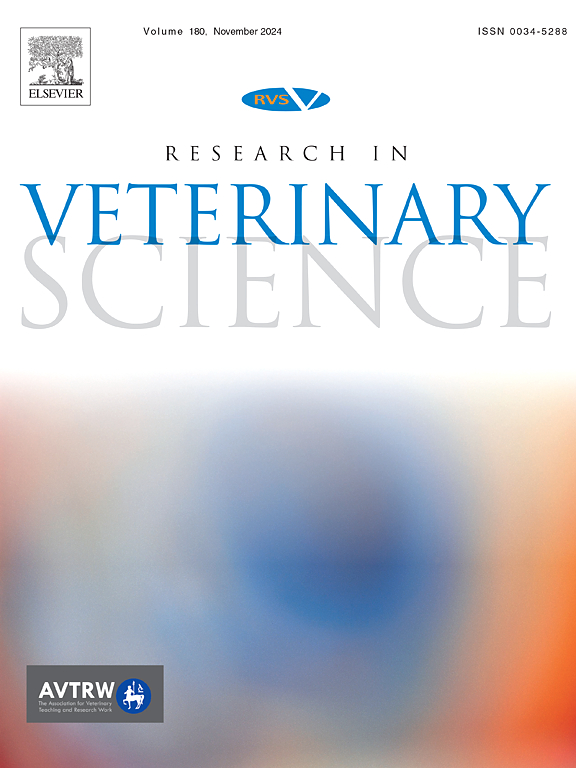Effect of the sarcoptic mange upon metabolome profiling in wild boars
IF 2.2
3区 农林科学
Q1 VETERINARY SCIENCES
引用次数: 0
Abstract
Sarcoptic mange is a highly contagious disease and represents one of the main health concerns for humans and non-human mammals worldwide. It is caused by the mite Sarcoptes scabiei and can course with different morphological and physiological presentations. Accordingly, aside from skin inflammation, hosts may experience changes in body condition, immune system, biochemistry, reproduction, and thermoregulation, although the understanding of the downstream metabolic burden is still missing. In this context, mange-derived fat store depletion and following imbalance of fatty acid composition might contribute to the severity of the illness. The lack of a tool for early detection of this etiological agent often results in significant financial losses for farmers and harm to animal welfare. Therefore, using targeted LC-MS/MS-based metabolomics approach, we sought to investigate the impact of sarcoptic mange upon metabolome profiling in the blood serum of mangy wild boars. Thirteen wild boars were analyzed in three different clinical conditions, namely when they were sick, during the therapeutic treatment with ivermectin, and when they were deemed recovered from the disease. We identified specific long-chain acylcarnitines highly abundant in the blood serum of the subjects within the infection phase, when compared to the ivermectin-treated and healthy conditions. Overall, data from our preliminary study highlighted the need for more accurate and broad-based studies, about the potential role of the long chain acylcarnitines in the metabolic homeostasis, to help early diagnose of the sarcoptic mange.
肉疥癣对野猪代谢组图谱的影响
疥癣是一种高度传染性疾病,是全球人类和非人类哺乳动物的主要健康问题之一。该病由疥螨引起,可有不同的形态和生理表现。因此,除了皮肤炎症外,宿主的身体状况、免疫系统、生物化学、生殖和体温调节都可能发生变化,但人们对其下游代谢负担的了解仍然不足。在这种情况下,疥癣导致的脂肪储存耗竭和随之而来的脂肪酸组成失衡可能会加重疾病的严重程度。由于缺乏早期检测这种病原体的工具,养殖户往往会遭受重大经济损失,动物福利也会受到损害。因此,我们采用基于 LC-MS/MS 的代谢组学方法,试图研究肉牛疥癣对癞皮野猪血清代谢组谱的影响。我们对 13 头野猪在三种不同临床情况下的血清进行了分析,即患病时、伊维菌素治疗期间和痊愈后。与伊维菌素治疗期和健康期相比,我们在感染期受试者的血清中发现了大量特定的长链酰基肉碱。总之,我们的初步研究数据强调了对长链酰基肉碱在新陈代谢平衡中的潜在作用进行更准确、更广泛研究的必要性,以帮助早期诊断肉皮癞病。
本文章由计算机程序翻译,如有差异,请以英文原文为准。
求助全文
约1分钟内获得全文
求助全文
来源期刊

Research in veterinary science
农林科学-兽医学
CiteScore
4.40
自引率
4.20%
发文量
312
审稿时长
75 days
期刊介绍:
Research in Veterinary Science is an International multi-disciplinary journal publishing original articles, reviews and short communications of a high scientific and ethical standard in all aspects of veterinary and biomedical research.
The primary aim of the journal is to inform veterinary and biomedical scientists of significant advances in veterinary and related research through prompt publication and dissemination. Secondly, the journal aims to provide a general multi-disciplinary forum for discussion and debate of news and issues concerning veterinary science. Thirdly, to promote the dissemination of knowledge to a broader range of professions, globally.
High quality papers on all species of animals are considered, particularly those considered to be of high scientific importance and originality, and with interdisciplinary interest. The journal encourages papers providing results that have clear implications for understanding disease pathogenesis and for the development of control measures or treatments, as well as those dealing with a comparative biomedical approach, which represents a substantial improvement to animal and human health.
Studies without a robust scientific hypothesis or that are preliminary, or of weak originality, as well as negative results, are not appropriate for the journal. Furthermore, observational approaches, case studies or field reports lacking an advancement in general knowledge do not fall within the scope of the journal.
 求助内容:
求助内容: 应助结果提醒方式:
应助结果提醒方式:


